According to a recent report by the Physicist Organization Network, Japanese scientists have discovered that changing the structure of polymers is expected to significantly improve the photoelectric conversion efficiency of solar cells made from them, and the latest research will help scientists to develop organics with higher conversion efficiency ( Or inorganic) polymer solar cells.
Organic polymer-based solar cells are very important because organic polymers are cheaper and easier to handle than polymers used in traditional inorganic solar cells. However, so far, the highest conversion efficiency polymer solar cells are still unable to meet the practical needs.
However, at present, Osaka Tosaka and colleagues at the emerging molecular functional research group of the Institute for Emerging Materials Science at the RIKEN Research Institute in Japan discovered by chance that small changes in the polymer structure can change the binding state of the polymer chains, and thus The earth improves the efficiency of solar cells.
When light energy is absorbed by a polymer in a polymer solar cell, the electrons are excited to a higher energy state to produce high energy electrons and a corresponding electron "hole". In order to convert light energy into electric current, these electrons and holes must reach the electrode through the polymer and then combine, but this process will lose a lot of energy. Many scientists are conducting various experiments and hope to improve this transformation process.
Osaka Toki and colleagues used a special type of copolymer that contained a repeating structure called PNNT-DT. Osaka explained that "PNNT-DT is very difficult to dissolve in water. Therefore, We hope to make it easier to handle by adding additional alkyl side chains to it.†As they expected, this change has greatly improved the solubility of this polymer, but “inadvertentlyâ€, This change also greatly improves the energy conversion efficiency of solar cells made from this polymer.
The polymer was placed as a thin film in a solar cell. Analysis showed that these new "alkylated" polymer chains were laid flat on the surface of the cell rather than perpendicular to the surface, making the charge carriers - electrons and holes. The surface moves vertically rather than parallel, thereby increasing energy conversion efficiency. Osaka Zhizhi said: "This change in structure and direction has increased the photoelectric conversion efficiency of solar cells from 5.5% without alkylation to 8.2% today."
Osaka Toki and colleagues hope that next, using other polymers for similar experiments, eventually produce organic polymer solar cells with a photoelectric conversion efficiency of more than 15% or more efficient inorganic solar cells. He said: "We need to better understand why the orientation of the polymer will change. Next, we need to perform the same experiment on other polymers that can absorb more visible light." (Liu Xia)
Musk Ambrette is a nitromusk once in common use, but now widely-regarded as toxic. Nitromusks are a group of synthetic fragrance chemicals typically used in cosmetics, perfumes, air fresheners, cleaning products, detergents, soap, and many other everyday products with artificial scents. Exposures to nitromusks in the general population are widespread, due to their presence in this broad variety of consumer goods.


Musk Ambrette
Musk Ambrette,Purity Musk Ambrette,Ambrette Musk Crystals,Musk Ambrette Definition
Gan Su Original Flavor Co.,ltd , http://www.futureperfume.com